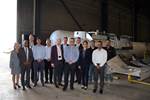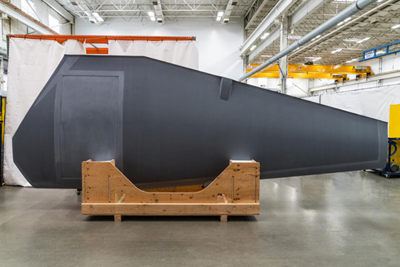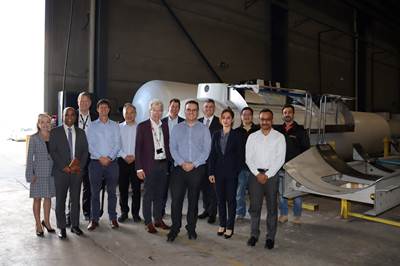Australian R&D project harnesses wave energy for USV underwater rudders
The ACM CRC, with Ocius Technology and the University of New South Wales, collaborate to bring bio-inspired FRP “flippers” tailored to achieve optimal propulsion for all weather conditions.
Source | ACM CRC
A new R&D project between the (ACM CRC, formerly SoMAC CRC; New South Wales, Australia), (Randwick) and the (UNSW) is set to optimize the use of wave energy for propulsion using composite materials, harnessing energy for underwater flippers for uncrewed surface vessels (USVs).
Bluebottle-class USVs are autonomous solutions developed by Ocius for continuous maritime surveillance. The technology has applications across oil and gas, security and scientific research, and is enhancing a range of maritime defense missions such as mine clearance, patrolling, environmental monitoring, and search and rescue operations.
As unmanned ocean vessels, it is imperative that USVs operate efficiently in the water at all times and navigate safely in open ocean transport channels. As a fully renewable surface vessel powered by solar, wind and wave energy, the Ocius Bluebottle is currently operating well but has limitations when used in strong winds.
“The ‘rudder flipper’ came out of biomimicry and was developed by trial and error into a third method of propulsion on a Bluebottle USV besides sun and wind. It also acts as a ‘sea anchor’ in bad weather.”
The wave energy used by the Bluebottle is facilitated by a fiber-reinforced laminated composite rudder, or “flipper,” at the front of the vessel, which provides passive thrust. This ACM CRC project aims to design and manufacture the next-generation composite flipper for these vessels, for optimal propulsion, thus enabling operation even in the toughest weather conditions and no matter the state of the sea.
“The tailorable stiffness of composite materials provides an opportunity to achieve additional thrust from flapping and morphing structures,” professor Ganga Prusty, director of research at ACM CRC, says. “Our R&D project exemplifies the CRC’s vision to unite its composite industry partners with ACM’s world-class academic researchers and deliver innovation at the forefront in automated manufacturing of advanced composites.”
The project will leverage what partners say is an innovative automated manufacturing procedure, integrating multidisciplinary techniques including scientific computing, optimization, artificial intelligence and advanced manufacturing.
Robert Dane, CEO of Ocius, sees the possibilities of this project, noting that Ocius has a strong history in conceiving, funding and delivering difficult, innovative, high-tech, award-winning projects with remarkable outcomes. “The ‘rudder flipper’ came out of biomimicry and was developed by trial and error into a third method of propulsion on a Bluebottle USV besides sun and wind. It also acts as a ‘sea anchor’ in bad weather, pointing the bow into high seas, which can go on for days. So the flipper needs to have properties of strength, resilience and memory and this 3-year project with ACM CRC will put scientific rigor around the design and manufacture and turn it into a real superpower.”
“Through this CRC project, UNSW is extending its relationship with Ocius with a clear focus on the commercialization of renewables and low emission technologies,” notes Jamie Conyngham, UNSW’s director of business development and commercialization. “Outcomes will create new supply chains and employment in the Australian advanced manufacturing sector, as well as reducing international supply vulnerabilities.”
According to associate professor Fangbao Tian, the project’s chief investigator, “The UNSW Canberra Flow Science team has been developing advanced computational fluid dynamics tools for multiprocess interactions over the last decade. As an important element of digital twins in engineering, advanced computational fluid dynamics will be used with artificial intelligence, optimization and biomimetic knowledge of aquatic animals to design flipper-based propulsors of superior performance in terms of thrust and reliability.”
Simulation technology development could also be applied to aero and hydrodynamic simulation of composite structures, such as surfboards, with improved efficiency of design and manufacturing guidance for robust flippers and similar products.
Related Content
Composites end markets: Boatbuilding and marine (2025)
As 2023-2024 consumer demand slows, boat and marine vessel manufacturers continue to focus on decarbonization and new technologies using composites.
Read MoreRevisiting the OceanGate Titan disaster
A year has passed since the tragic loss of the Titan submersible that claimed the lives of five people. What lessons have been learned from the disaster?
Read MoreAl Seer Marine, Abu Dhabi Maritime unveil world’s largest 3D-printed boat
Holding the new Guinness World Record at 11.98 meters, the 3D-printed composite water taxi used a CEAD Flexbot to print two hulls in less than 12 days.
Read MoreLarge-format AM speeds plug production for manufacture of composite boat molds
Hungarian manufacturer Rapid Prototyping transitioned its conventional foam milling process to 3D printing to produce faster, higher quality, recyclable foam plugs and composite boat molds.
Read MoreRead Next
Janicki supports Saildrone Voyager program
Engineer and manufacture of technologically challenging composite components for the 33-foot uncrewed surface vehicle will scale up Saildrone fleet capability, meet the demanding challenges of ocean mapping.
Read MoreOmni Tanker, SOMAC CRC partner to improve Australian composites manufacturing
Partnership to create a digital twin of Omni Tanker’s pilot production plant to transform operational and strategic composites manufacturing performance.
Read MoreCutting 100 pounds, certification time for the X-59 nose cone
Swift Engineering used HyperX software to remove 100 pounds from 38-foot graphite/epoxy cored nose cone for X-59 supersonic aircraft.
Read More












